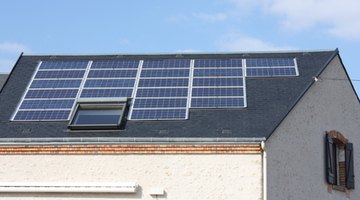How to Hook Up Batteries to Solar Panel
Photovoltaic (PV), or solar, panels are designed to deliver a preconfigured output voltage, usually 12, 24 or 48 volts, but the true output voltage fluctuates during the day as the weather conditions vary.

Things You Will Need
- PV charge controller
- Deep-cycle solar batteries
- Battery cables
To avoid overcharging the batteries, these fluctuations must be regulated by a PV charge controller installed between the panels and the battery bank. Also, for the batteries to use the charge generated by the panels, the voltage of the bank must be the same as the listed output from the panels.
-
Connect the solar panel configuration to a PV charge controller. This controller conditions the uncertain voltage from the panel so that it can be used to charge the batteries. It also protects the batteries from overcharging and protects the panel from the batteries when the sun goes down. Choose one with a low passive current draw so that the batteries will remain charged when the sun is down and there is no load.
-
Configure the battery bank to the same voltage as the listed output voltage of the panels by connecting the batteries together in series, parallel or both. Remember that wiring two batteries in series doubles the voltage while wiring them in parallel maintains the voltage of one battery, but doubles the capacity of the bank.
-
Create a 12-volt bank from 12-volt batteries by wiring all the batteries in parallel, connecting all the positive terminals and all the negative terminals to each other.
-
Create a 24-volt bank by wiring pairs of 12V batteries in series. Do this by connecting the positive terminal of one to the negative of the other. Connect these pairs together in parallel to form the bank.
-
Create a 48-volt bank by wiring sets of four 12V batteries in series, and then connecting the sets in parallel to form the bank.
-
Connect the positive and negative terminals of the battery bank to the designated terminals on the PV charge controller and connect the controller to an inverter, following the wiring diagram on the controller. The inverter will convert the DC battery current to 110V AC household power.
Tip
Use the same size and length of battery cable to make all battery connections. Store the batteries in a cool, dry, well-ventilated location and maintain them regularly. Higher voltage systems are efficient over longer distances and require smaller gauge wire. Consider this when purchasing your panels and sizing your battery bank.
Warning
Batteries that are fully charged can deliver a severe electrical shock.
References
Tips
- Use the same size and length of battery cable to make all battery connections.
- Store the batteries in a cool, dry, well-ventilated location and maintain them regularly.
- Higher voltage systems are efficient over longer distances and require smaller gauge wire. Consider this when purchasing your panels and sizing your battery bank.
Warnings
- Batteries that are fully charged can deliver a severe electrical shock.
Writer Bio
Chris Deziel has a bachelor's degree in physics and a master's degree in humanities. Besides having an abiding interest in popular science, Deziel has been active in the building and home design trades since 1975. As a landscape builder, he helped establish two gardening companies.
Photo Credits
- Solar energy image by lefebvre_jonathan from Fotolia.com
- Solar energy image by lefebvre_jonathan from Fotolia.com
More Articles


